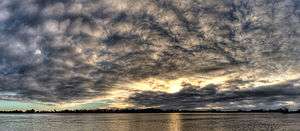Diego García de Moguer
Diego García de Moguer (1484 or 1496–1544) was a Spanish explorer who also sailed for the Portuguese Crown later in life.[1]
Biography


Spanish sources indicade that Diego García was born in Moguer in 1484 (or 1496[2]), but there are Portuguese sources say he was born in Lisbon. However, his first expedition, in 1515, was with Juan Díaz de Solís in search of an oceanic passage leading to the Far East, returning to Spain after the death of Díaz de Solís in the Río de la Plata basin in 1516.[2] He participated in the expedition of Ferdinand Magellan and Juan Sebastián Elcano between 1519 and 1522.[3]
García received approval for a new voyage.[4] On 15 January 1526 (15 August 1527 is also mentioned[2]) he sailed from La Coruña, Cape Finisterre, in command of an expedition with three ships. The voyage was financed by merchants to find a suitable spice route, intended to follow Elcano's route and passing through the Magellan Strait.[5] After voyaging through the Atlantic Ocean, García arrived on the south coast of Brazil.[2] In February 1528, he explored the area around the Río de la Plata, an excursion documented in José Toribio Medina's Los viajes de Diego García de Moguer (The travels of Diego García de Moguer).[6]
As he navigated through the Paraná River in early 1528, he met men from the Sebastian Cabot group. He was informed that Cabot was at the fort of Sancti Spiritu located at the confluence of the Paraná River in Carcaña. With a ship and a barquentine,[3] García navigated the Paraná River, arriving at the Sancti Spiritu fort. He was surprised and indignant to find Cabot there. He ordered Captain Caro to abandon the place as he, García, alone had been charged by Spain to explore the region. However, after it was explained that Cabot was also in the service of Spain, they joined forces.[5] García continued upstream between what are now the towns of Goya and Bella Vista where he met Cabot who forced him to cooperate in trying to find the legendary Sierra de la Plata.
Together they explored the Pilcomayo River and then followed it as far as the strait. Garcia and Cabot continued their attempts to explore the mythical kingdom about which they had heard from Captain Francisco Cesar, hearing that the place was rich in gold, silver, and sheep (llamas) with which fabrics were made. It was the Inca Empire of the legendary City of the Caesars in Chile.[2] Arguments between García and Cabot eventually ended both expeditions, the two men returning to Spain to settle their disputes through legal measures.[7] The dispute arose as García claimed full control of the area he had explored. In the court case which was held in Spain the verdict went in favour of García. The reason was that Cabot who was assigned to go to the Spice Islands never went there but explored the Sierra de la Plata which was a violation. As a punishment he was exiled for two years to Oran.[7]
As a result of all the feuding between García and Cabot, the Spaniards failed to ensure the defense of the fort at Sancti Spiritus, which was attacked by the natives in September 1529 while Cabot and García were in San Salvador.[8] In late September or early October 1529, García's caravel traveled to the Ducks Bay (in southern Brazil), picked up Francisco García (who belonged to Cabot's expedition) and traveled to Spain, arriving there on 28 July 1530.[2]
Cabot abandoned a planned expedition to the Spice Islands.[9] Instead, on 21 May 1534, Diego García de Moguer sailed his caravel Concepción back to Río de la Plata.[10] He passed the Cape Verde island of Santiago, then continued to Brazil and on to the estuary of the Uruguay and Paraná rivers.
References
- ↑ Porchat, Edith (1956). Informações históricas sobre São Paulo no século de sua fundação (in Portuguese). Editora Iluminuras. p. 61. Retrieved 17 May 2014.
- 1 2 3 4 5 6 "Moguer Garcia, Diego (ca. 1495-ca. 1535)." (in Spanish). Mcnbiographicas.com. Retrieved 24 June 2013.
- 1 2 Parry, John Horace (1979). The discovery of South America. Taplinger Pub. Co. p. 249. ISBN 978-0-8008-2233-0.
- ↑ El Descubrimiento y la fundación de los reinos ultramarinos: hasta fines del siglo XVI (in Spanish). Ediciones Rialp. 1982. pp. 403–. ISBN 978-84-321-2102-9.
- 1 2 Pohl, José Álvarez de Luna y (1919). Expedicion de Diego García al Rio de la Plata en 1526 (in Spanish). Sevilla. p. 6.
- ↑ Gollán, Agustín Zapata (1942). Caminos de la Colonia (in Spanish). Universidad Nac. del Litoral. p. 12. ISBN 978-950-9840-17-1.
- 1 2 Thomas, Hugh (23 August 2011). The Golden Empire: Spain, Charles V, and the Creation of America. Random House Publishing Group. pp. 417–. ISBN 978-1-58836-904-8.
- ↑ Marley, David (2008). Wars of the Americas: A Chronology of Armed Conflict in the Western Hemisphere, 1492 to the Present. ABC-CLIO. p. 42. ISBN 978-1-59884-100-8.
- ↑ Robertson, James Alexander (1946). The Hispanic American Historical Review. Board of Editors of the Hispanic American Review. p. 463.
- ↑ Medina, José Toribio (1908). Los viajes de Diego García de Moguer al Rio de la Plata: estudio histórico. Impr. Elzeviriana. p. 159.